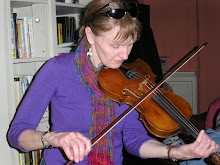 To get from Edinburgh to St. Andrews, you cross the new Forth Bridge. The old Forth Railroad bridge, a cantilever bridge, is considered to be the 8th wonder of the world. Completed in 1890, it was the world's first major steel bridge and still carries many trains a day. http://www.forthbridges.org.uk/railbridgemain.htm
To get from Edinburgh to St. Andrews, you cross the new Forth Bridge. The old Forth Railroad bridge, a cantilever bridge, is considered to be the 8th wonder of the world. Completed in 1890, it was the world's first major steel bridge and still carries many trains a day. http://www.forthbridges.org.uk/railbridgemain.htmMost people think of golf or the university when they hear, St Andrews. The town is also home to Di Gilpin Knitwear. (In the photo Marjorie Ann is modling one of Di's sweaters.) Di presented a slide lecture for us of her journey as an artist knitter. She started knitting when she was 6. To make money while in university, she would knit things for people. After a stint as an English and history teacher, she moved to the Isle of Skye. For 5 years she knit, painted and took photographs, inspired by the beauty of the water and mountains out her window. She opened up Struan Knitwear and people started coming. Her goal has always been to get people to knit and over the last 26 years, she has been successful in bringing it back into vogue in Scotland.
Di's early work focused on Fair Isle patterns and intarsia color work. Now in addition to those, she works with lace weaves, deconstruction and a technique she developed called “knit-weave.” Di designs for companies, writes books, travels for inspiration and to teach. She is now starting to make many of her knitwear patterns available to purchase from her website. http://www.digilpin.com/
In 2000 she moved her studio and shop to St. Andrews. A large knit club gathers there regularly and she offers one, two , and three day workshops. Di knits and designs as she goes, taking technical notes. “I let pattern come through me and develop. I never have a pre-conceived idea." Once the piece is complete, she creates the pattern and the directions. “I think my work is innovative because I come at it from both the technical side and the creative side at the same time. Knitters like to think. I put knitters high on the intelligence stakes.”
The sun always seems to shine when I bring groups to this town. Here are Uarda, Kathy and Pat enjoying a cup of tea.


North of St. Andrews lies Dundee,known for 'jute, jam, and journalism.' It was once known as “Jutopolis.” Over 50,000 workers worked in the jute mills. Verdant Works Jute Mill, built in 1833 , was the 16th largest of 61 milles. The last of the jute mills closed in 1997. Verdant Works is now a museum depicting the days when jute was king in the city on the River Tay. http://www.verdantworks.com/
 Jute fiber was brought by ship from India. Large bales were brought to the factories where it was processed, spun into yarn and woven into cloth. Boys only worked in the mills until they were 18, when they were made redundant. Women comprised the majority of the workers in the mills and had a lot of power. We had an excellent guide, Earl Scott, who lead us through the interpretive displays. Each time I come to the museum there is something new and this year it was an excellent film showing the task that each machine played in the processing of the raw material into cloth and rope.
Jute fiber was brought by ship from India. Large bales were brought to the factories where it was processed, spun into yarn and woven into cloth. Boys only worked in the mills until they were 18, when they were made redundant. Women comprised the majority of the workers in the mills and had a lot of power. We had an excellent guide, Earl Scott, who lead us through the interpretive displays. Each time I come to the museum there is something new and this year it was an excellent film showing the task that each machine played in the processing of the raw material into cloth and rope.Now there are no jute mills left in Dundee. Some of them have been torn down, others turned into housing and others refitted for other industry. But no industry since has matched the success of the jute mills in the 19th and early 20th century. A number of songs tell the stories of working in a jute mill. My group, Straw into Gold has recorded 2 of them, Sheena Wellington’s “The Weavers o Dundee” and Mary Brooksbank’s “The Jute Mill.” You can
 listen to this second song at http://www.singingweaver.com/ by clicking on the revolving musical symbol on the home page.
listen to this second song at http://www.singingweaver.com/ by clicking on the revolving musical symbol on the home page.If any of you traveled to the U.K. twenty or just ten years ago, you may laugh when I say the food in Scotland is excellent! But indeed Scotland has come a long way with their cuisine. Many places focus on using local ingredients to prepare healthy and tasty fare. This night we enjoyed a special feast, “A Taste of Grampian” at the Barn and Bushel in Thainstone. Each Saturday night, they feature locally raised foods such as angus beef, venison, lamb, fish, parsnips, potatoes...well actually you get potatoes in one form or another served in abundance at every restaurant! Since Barn and Bushel is located at a livestock market area, the beef, pork and lamb are especially fresh. www.goanm.co.uk/highlandcuisine

No comments:
Post a Comment